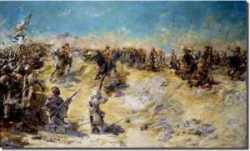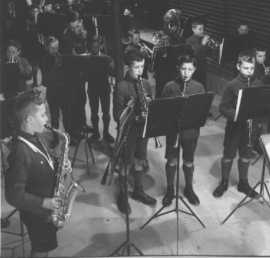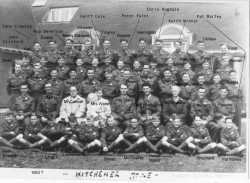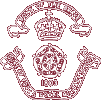| Navigation links at the bottom of this page |
| The last of the CSMs |
CSM Rowson, long-time company sergeant-major of G Coy (or Kitchener House as it became after WWI) was the Colonel's trumpeter of the 21st Lancers at the time of its famous charge of the Dervishes at the Battle of Omdurman in September 1898. The Colonel led the charge and Rowson stuck by his side throughout the charge. Trumpeter Rowson, barely on man service, is believed to be the figure on the Colonel's right in the accompanying illustration. CSM Tubby Rowson frequently regaled boys in the day room of an evening with a description of the famous charge in which Winston Churchill took part and described in The River War. According to Rowson's description of the battle, the topography was different from that shown in the battle scene depicted. The a large contingent of the Ansar forces (sometimes known as Dervishes) was assembled in a depression hidden from the view of the 400-strong 21st Lancers sent by General Kitchener ahead of the his army's general advance on the village of Omdurman. Settled on the ground, resting and relaxing in loose groups awaiting orders, the Ansar force was secluded from view. Moving in line abreast across the open plain and coming upon the enemy, the 21st was as surprised as the Dervishes by the unexpected confrontation.
The 21st had been advancing across the plain at a steady pace and under rifle fire from what seemed to be isolated groups of enemy skirmishers. Here CSM Rowson's account differs from the official account, which for the record is here related. According to Trumpeter Rowson, as he was then, the colonel's trumpeter, he sounded the charge as ordered and alongside his commanding officer plunged down the slope of a declivity hidden from the plain above. To their astonishment the groups of skirmishers, some at rest on their haunches, were masking from the view of the charging 21st Lancers thousands of their fellows, also at rest in a wadi (dry river bed) awaiting orders.
Rowson stuck close to his colonel's side and blew his bugle for all he was worth, which may have startled the enemy, but not for long. They scrambled to their feet to defend themselves against the thundering 21st, lances now drawn to do their work. Rowson dropped his bugle and drew his sword.
|
| The subsequent clash was fierce and the casualties high: five officers, 65 men died in the action and 120 horses were lost. [The regimental history records a loss of 21 men killed and 50 wounded.] If CSM Rowson's account is to be believed, many of the troopers unhorsed were rescued by their fellow lancers to ride to the far side double-mounted. Three VCs were won by troopers who rescued comrades from the fray. While CSM Rowson was not among those so honoured for their bravery, he never tired of relating this most famous of battles of the 21st Lancers - that afterwards became known as the Queen's Royal Lancers - and his part in it. |
 |
Public domain, courtesy Wikipedia
Charge of 21st Lancers at Battle of Omdurman, 1898 |
 |
|
|
| By the beginning of the Second World War, Rowson was in his early sixties. By the time the School was evacuated, first from Dover to Cheltenham, then to Saunton Sands in North Devon, the CSM from the Queen's Royal Lancers had gone into retirement. His place was taken in 1941 by an entirely different man. |
 |
Band Sergeant William (Bill) Fry of the 11th Foot (The Devonshire Regiment) arrived at the Saunton Sands Hotel in battledress with his sergeant's stripes and band harp on his sleeve. The harp signified that he was a musician. Within two days of his arrival to take charge of Kitchener House (G Coy), the new CSM was outfitted in a standard WWI throat-choking jacket with a sergeant major's emblem on his sleeve. So began Bill Fry's long service teaching the boys of B Division the rudiments of music and tutoring them in the musical instruments to which each been assigned.
He was known to the boys of Kitchener house by various nicknames over the years. To older boys who were at Dover before the evacuation, he was simply G Coy Fry, the 'G Coy' being a holdover from the days when companies were known only by their alpha designations. He soon acquired the nickname of Jan Fry and later as 'Janks' or 'Janker Fry.' He impressed boys in different ways. |
B Division band practice
Fred Cockerill & Edward Grant at centre music stand
with CSM Fry at left rear |
|
|
|
 |
|
Ted Grant, who appears in the photograph of B Division at band practice, writes:
Mention of Bill Fry (known to all as G Coy Fry) rekindled memories of my early days at Saunton. When it was decided I should join Roberts (not quite sure how these decisions were made), Bill became my musical tutor and taught me all I know about "F one flat B" etc. He first tried me out on the French horn, which I did not take to, likewise the cornet, something about the wrong lips! We finally agreed on the clarinet, which turned out to be the right choice as I played it through my school years, for three years in the Arborfield Army Technical School band and a couple of years in the REME band. I remember once marching across the grassed area in front of the Saunton Sands Hotel on my way to band practice, using my clarinet as a drum major's mace forgetting that CSM Fry had his office at that end of the hotel. I received a summons to visit his office, got a clip around the ear for my sins and told that I was too short to be a drum major anyway. After that we seemed to get along okay. There is a little story about that photo of B Division. It was one of only two that I recall having taken at the school. For many years, I badgered my brothers to find it for my family tree album, but to no avail. Two years ago, during a visit to Dover, I was leafing through a collection of photographs of Saunton in the school museum and much to my surprise came across that same photograph. Mike Carson, who manages the museum, told me that the photograph was on display in The Imperial War Museum, London. So Bill Fry, Fred Cockerill and I are preserved in perpetuity, however long that is!
Another correspondent, Jim Dove, wrote:
'… our generation knew him as Janks or Jankers because he threatened us with jankers for every minor discretion. Even after forty years I can in my mind hear his foghorn-like voice chanting scales while thumping the wooden floor of B Division with the long stick he used. That stick was a useful instrument, for he used it both to maintain our rhythm, to 'assist me' in keeping my flute parallel to the ground, and my pal, a euphonium player, to sit upright with his backside tucked under his head and shoulders rather than providing a perch for birds.'
|
| Another writer thought Jan Fry had a derisive attitude towards the corps of drums, for anyone who had the temerity to ask about transferring to the drum corps (which included the bugle and piccolo players known as the 'spit and dribbles') would be lectured about the idiocy of 'blowing your brains out on a bugle' rather than becoming a skillful musician, which would set you up for life - join a dance band etc. |
Kitchener House 1953 |
 |
|
|
 |
 |
|
|
Reminiscing of a time long gone, Tony Cook, wrote:
'Janks' Fry? Mention Miss Bean [house nurse] and his name pops up. I used to hate him because he scared me as a young boy learning to play the cornet in the B Division band room as he pounded out the time with his wooden staff on the floorboards. It probably didn't help that the exercise highlighted the fact that my eyesight needed some artificial assistance so I wasn't able to see the fingering painted on the scales on the wall. After he retired I used to go out of my way to avoid him if I saw him coming. In later years, I found we had both changed. We'd
always stop for a chat. In 1987, the band I was playing in had just finished a playing tour of Switzerland, Scandinavia and England (just Portsmouth as part of the official bi-centenary celebrations for the sailing for the First Fleet) so I took a couple of weeks off to scout around before heading back to Melbourne. I visited the school and was in the band room talking to someone when I was told that Janks was still living in Dover. I took the address and went to see him. He was showing his age then, but we enjoyed a cuppa tea together - his pride wouldn't let me make it for him - and shared a few laughs. His memory was amazing. He never forgot a face, so when it came time for me to leave (much later than I'd planned) I felt quite sad.
Ray Pearson saw another side of Jan Fry who with his wife, when he retired, bought a bungalow in the village a short distance from the Guston Gate. A certain Welsh Druid of a headmaster at the time, Ray recalls, had a strong distaste for old boys and the OBA, maintaining that they represented a disreputable and less than respectable past. He banned alcohol from the school premises, so Jan Fry hired a marquee at his own expense every Grand Day and Remembrance Day, had it erected on his property and stocked it with beer for his many visitors. They would each drop ten bob on a plate when they drew a pint so that, by this arrangement, Jan Fry broke even. That was very much to everyone's satisfaction. |
| In 1987, by then aged, frail and a widower, Bill Fry became a Chelsea pensioner at the Royal Chelsea Hospital. Ray Pearson visited him whenever he was in the area and was sure of a welcome. Jan Fry enjoyed reminiscing about his time at the school - and so passed the last company sergeant major of Kitchener House (G Coy) and one of the last CSMs on the staff of the School. |
 |
| Colonnade of the Royal Hospital Chelsea. |
|
|
 |
|
|





